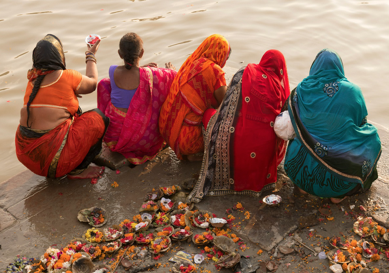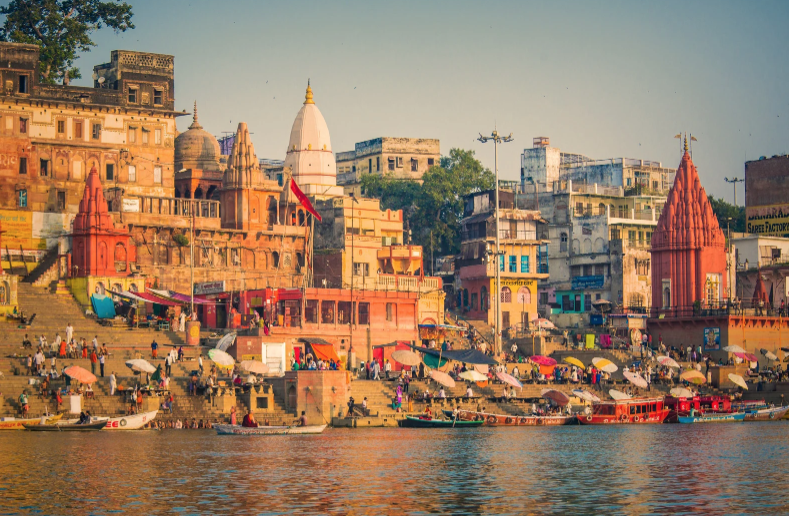The city where the most intense life and the most tranquil death coexist naturally.
Life on the Banks of the Ganges River
Benares, popularly known as the City of Light, is the city with the most contrasts in India. Bathed and blessed by the presence of the Ganges River, it is the oldest continuously inhabited city in the world throughout history.
This city awakens the senses of every traveler who visits it and purifies the sins of all the faithful who pilgrimage to it. It is a noisy, chaotic, mystical, and very mysterious place that has captured eager travelers and writers to discover its magic, but there are no words, however expert they may be, that can explain the vibration of this place, and the only way to feel it is by getting lost in its streets and immersing yourself in its rituals and spirituality.

Life and death around the Ganges River
Life in Varanasi is always connected to the Sacred River, where the most mundane activities blend with the most spiritual. The Ganges River originates in the foothills of the Himalayas, traverses the Indian geography for 2500 km, with its passage through Varanasi being one of the most revered, and concludes its journey at the Bay of Bengal, in Kolkata.
As the shy morning sun begins to shine, the Ghats, those stone steps that descend into the Sacred River, come alive with the arrival of pilgrims, the ringing of bells, and the sound of mantras echoing in every corner.
Devotees travel hundreds to thousands of kilometers to reach the holy city with the desire to purify themselves in the waters of the Goddess Ganges. Every Hindu should visit the city of Varanasi at least once in their lifetime, and this accounts for the daily influx of arrivals this place witnesses.
Prayer and offerings to the goddess Ganges
On the riverbank, the Saints coexist, blessing the pilgrims, while the faithful immerse themselves in the sacred waters to cleanse their sins and take their time to pray without haste. They offer garlands of flowers and oil lamps to the Goddess Ganges, symbolizing light over darkness and ignorance. Additionally, this melting pot of people includes cows and goats inhabiting the area, children playing on the shore, boats navigating the waters, and housewives washing their clothes in the river, adding color to the scene with their saris laid out in the sun.
The steps are bustling with life throughout the day, but when the sun sets, magic happens. With dusk, the Aarti, the offering to the goddess Ganges, is celebrated. This sensory spectacle takes place in several cities across India, with Benares hosting the largest and most popular one. Mantras are sung to attract the attention of the Goddess, welcoming her with the sound of conch shells, and the area is filled with the scent of incense that purifies the atmosphere to receive her. Then, an offering is made of the five elements represented by oil lamps symbolizing fire, flowers representing earth, water from the river, air created with peacock feather fans, and space represented by a fan made of yak tail. A unique experience for both believers and visitors alike.

Photograph by Isabel Gil
Aarti Ceremony in Varanasi
Death in Varanasi is also connected to the Sacred River and is understood as something natural and part of the cycle of life. Through its alleyways, you will find rows of men carrying the deceased, chanting, and heading towards the Cremation Ghat. In the city, there are two areas for this ritual, with the Manikarnika Ghat being the most famous and crowded.
Thousands of Hindus are brought to the Holy City once they pass away. And many others, feeling the end of their earthly days approaching, travel to Varanasi to die. As it is the greatest blessing to do so in this city protected by the God Shiva. The relatives of the deceased arrive in Varanasi with the absolute desire that their loved one achieves liberation (moksha) and ends their cycle of reincarnations. In the cremation ritual, there are no tears, and it is understood as the beginning of a new life.
It’s a concept that not all Westerners who visit Varanasi understand, but one from which we can learn a lot. Varanasi has followers whose magic captivates them and detractors who cannot survive its streets and chaos. But if there is one thing in common among both profiles, it is that this city leaves no one indifferent and provokes a whirlwind of emotions that endure over time.
